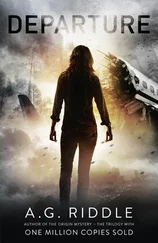“You’re awfully sure about that stuff for a civilian,” Sergeant Fallon tells her.
“I may not know anything about weapons, but I know mathematics and physics,” she replies.
“If it’s such a sure thing, why hasn’t anyone ever had the same idea before?” Colonel Decker asks. He’s clearly not enamored with the idea, and his body language is somewhere between frustration and defiance.
“Because it’s nuts,” Colonel Campbell says from orbit. “And because we usually don’t see them coming. Besides, you never put all your cash on one hand unless you’re desperate.”
“I don’t know about you folks,” Sergeant Fallon says, “but I think desperate pretty much hits the nail on the head right now.” She looks at the administrator. “Of course, I’m open to other ideas, if anyone has any. Right now the Freighter of Doom plan sounds a little nuts. But if the only alternative is to let them land and hope we can nuke them, I’ll take a little nuts .”
“I concur,” Lieutenant Colonel Kemp says, and his sergeant major nods his agreement.
“Let’s have a tally,” Sergeant Fallon says. “All in favor of the Freighter of Doom, raise your hands.”
Colonel Kemp and I raise our hands. Dr. Stewart looks around the room as if she’s unsure whether she has a vote as well, and then raises her hand, too. The administrator joins us.
“All opposed to that crazy-ass idea, raise hands.”
Colonel Decker’s hand shoots up. After a few moments, the sergeant major of the 309th also votes against the plan. The deputy administrator of the colony adds his vote to the “opposed” tally as well.
“Mark me down as ‘for,’” Sergeant Fallon says. “That’s five to three. I guess it comes down to you and the Gordon ’s skipper, Colonel Campbell.”
For a few moments, we hear nothing over the tight-beam line. Then Colonel Campbell comes back on with a sigh.
“ Indianapolis and Gordon concur with the crazy option,” he says. “And the Gordon ’s skipper says his new boat is a piece of shit anyway, and he hopes it will make a better missile than a freighter.”
CHAPTER 25
OPERATION DOORKNOCKER
Outside, the weather has improved a little over the zero-visibility blizzard that kept us inside yesterday. The snow has slacked off, but the cold winds that are whipping through the spaces between the reinforced concrete domes of the airfield buildings are still bitingly cold.
I walk out of the airfield’s control building and immediately have to suppress the urge to lower the visor of my helmet. Dr. Stewart, who is following me onto the tarmac, is wearing a borrowed military vacsuit that looks about five sizes too big for her.
Out on the landing pad in front of the main hangar, one of our hijacked Dragonflies is standing with the tail ramp open and the engines running. Even though the fleet units are out on an intercept trajectory several hours out from New Svalbard, using a third of our offensive air power to shuttle two people up to the Indianapolis seems exceedingly wasteful and unwise, but the Indy ’s stealth birds don’t have passenger capability and can’t pick us up.
“When’s the last time you’ve been up in space?” I ask Dr. Stewart as we walk up the Dragonfly’s ramp. She is eyeing the interior of the cargo bay, which is lined with the usual complement of sling seats for fully armored combat grunts.
“Not since I arrived here,” she replies. “Three years, nine months. I’ve never hitched a ride in one of these, though.”
“Dragonfly-class drop ship. It’s a mean little beast. Holds a full platoon of Spaceborne Infantry in armor and does the fire support once the troops are on the ground.”
“It looks mean,” she concurs.
There’s no loadmaster, just the two pilots up front. I walk over to the loadmaster console and tap into the cockpit comms.
“Passengers loaded. Give us thirty seconds to strap in, and then let’s get her upstairs. Are you sure you’re qualified to do orbital docking maneuvers?”
“Yeah, no sweat,” the pilot replies in the lazy drawl they seem to teach in Combat Flight School. “I’ve read the manual. Can’t be all that hard if the fleet jocks can do it.”
Dr. Stewart is struggling with the harness of one of the passenger seats, and I walk over and help her with the straps.
“Thanks,” she says. She looks about as nervous as I felt when I took my first drop-ship ride in a Territorial Army Wasp, five years and half a lifetime ago on Earth. I check her helmet seal and plug her suit and helmet into the ship’s oxygen and comms circuits.
“If we get decompression, your helmet shield will lower automatically. That won’t happen, though. There’s nothing around that can shoot at us. So just sit back and enjoy the ride.”
I take the seat next to hers and strap myself in. The pitch of the engines changes, and I can feel the Dragonfly lifting off the deck. Then we’re in forward motion, and a few moments later the pilot goes full throttle and points the ship into the sky. I tap into the optical systems of the Dragonfly and watch the feed from the multitude of external sensors on the hull.
“You want to see your little moon from above?” I ask Dr. Stewart over the intercom link.
“Can I?” She looks around. “This thing doesn’t have any windows.”
I reach over and lower the visor on her helmet. Then I share the camera feed with her and cycle it through the multitude of views from the optical array. The sky over the settlement is the color of dirty snow. The cloud cover stretches from horizon to horizon now, and as we ascend through the low clouds hanging over New Longyearbyen, the seventy-ton drop ship gets buffeted by the winds.
“We really weren’t meant to live in places like this,” I say.
“Why not?” she asks.
“So much effort just to stay alive,” I say. “Ten years of terraforming, and if I step out of the admin building without heated armor, I’ll be dead from exposure within fifteen minutes.”
“That’s what we do,” Dr. Stewart says. “As a species, I mean. Earth is no cozy womb, either. Never has been. This is no worse than Antarctica, and we’ve had cities there for half a century now. You’ve been around the colonies, haven’t you?”
“You could say that.”
“Then you know how much we can adapt. We have to. Earth is getting too small for all of us.”
I think of the place where I lived until I joined the service—humans stuffed into concrete shoeboxes and stacked a hundred high, then crammed next to each other for dozens of square miles. Weekly food allowances, occasional treats through vouchers for better food, and a small hope for a shot at a better life, the colony lottery. I know damn well that Earth is already too small for us, but I also know how small the colonies are, how long it takes to make a planet or moon even minimally habitable, and how quickly the population grows back home even with mandatory birth control in the food for welfare rats. We were running out of time long before the Lankies started to take everything away from us again. As a species, they seem much better at the adaptation game.
The cloud cover on New Svalbard seems to extend forever. When we finally break out of the zero-visibility layer of white that covers this part of the moon like a shroud, the altimeter readout from the computer shows twenty thousand feet. The sky is the color of cobalt, with the far-off sun a small but bright sphere near the cloud horizon, and the much closer blue orb of Fomalhaut c taking up a quarter of the sky behind us. Fomalhaut c is the gas planet around which New Svalbard orbits, twice as far away from its parent sun than Neptune is distant from the sun in our home system. It’s a pretty sight, but it reminds me of the mind-boggling vastness of the universe, and how far away from other members of our species we are right now.
Читать дальше












